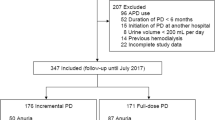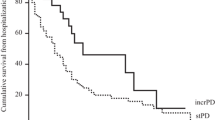Abstract
Background
The advantages of an incremental dialysis start are not fully clear. We aimed to evaluate the association of incremental initiation of peritoneal dialysis with mortality.
Methods
Incident peritoneal dialysis patients with a catheter placed at our hospital between 2008 and 2017 were included. All patients were followed up until December 31, 2019. Patients were categorized into different groups according to the initial daily dialysis exchanges, and were matched at a ratio of 1:2 with propensity score matching. Multiple variables including age, sex, residual kidney function, urine volume, hemoglobin, serum albumin and other important variables were included for the matching. Primary outcomes were all-cause and cardiovascular mortality.
Results
A total of 1315 patients with a mean age of 45.9 years were enrolled. The mean glomerular filtration rate was 4.32 ml/min/1.73 m2 at start of dialysis. Two hundred eighty-five patients in the incremental group and 502 in the full dose group were matched for age, sex, residual kidney function, urine volume, hemoglobin, serum albumin and other important variables. Patient survival and cardiovascular event-free survival were similar between the two groups. However, during the first 6 years of peritoneal dialysis, patients in the incremental group had better survival (P = 0.011) and cardiovascular event-free survival (P = 0.044) than the full dose group, while such advantages disappeared when dialysis vintage became longer. Further analysis showed that the incremental group (vs full dose dialysis) had a 39% lower risk (95% CI 0.42–0.90, P = 0.012) of all-cause mortality and a 41% decreased risk (95% CI 0.35–0.99, P = 0.047) of cardiovascular mortality during the first 6 years of dialysis. Additionally, the cumulative hazard for anuria was significantly lower in the incremental group versus the full dose group (P = 0.006).
Conclusions
Our study shows a time-related survival advantage for incremental peritoneal dialysis patients, suggesting that an incremental regimen for starting peritoneal dialysis is feasible and is not associated with worse outcomes.
Graphical abstract

Graphical Abstract presenting schematically the measurements of the solvation response function by processing the relevant streak camera images and the time-correlated photon counting (TCSPC) data and appropriately combining them together.




Similar content being viewed by others
Data availability statement
All data generated or analyzed during this study are included in this article. Further inquiries can be directed to the corresponding author.
References
Thomas B, Wulf S, Bikbov B, Perico N, Cortinovis M, Courville de Vaccaro K et al (2015) Maintenance dialysis throughout the world in years 1990 and 2010. J Am Soc Nephrol 26:2621–2633. https://doi.org/10.1681/asn.2014101017
Brown EA, Blake PG, Boudville N, Davies S, Arteaga Jd, Dong J et al (2020) International Society for Peritoneal Dialysis practice recommendations: prescribing high-quality goal-directed peritoneal dialysis. Perit Dial Int 40:244–253. https://doi.org/10.1177/0896860819895364
Auguste BL, Bargman JM (2022) Peritoneal dialysis prescription and adequacy in clinical practice: core curriculum 2023. Am J Kidney Dis. https://doi.org/10.1053/j.ajkd.2022.07.004
Reddy YNV, Mendu ML (2020) The role of incremental peritoneal dialysis in the era of the advancing American kidney health initiative. Clin J Am Soc Nephrol 15:1835–1837. https://doi.org/10.2215/cjn.03960320
Neri L, Viglino G, Cappelletti A, Gandolfo C, Barbieri S (2003) Incremental dialysis with automated peritoneal dialysis. Adv Perit Dial 19:93–96
Lee Y, Chung SW, Park S, Ryu H, Lee H, Kim DK et al (2019) Incremental peritoneal dialysis may be beneficial for preserving residual renal function compared to full-dose peritoneal dialysis. Sci Rep 9:10105. https://doi.org/10.1038/s41598-019-46654-2
Sandrini M, Vizzardi V, Valerio F, Ravera S, Manili L, Zubani R et al (2016) Incremental peritoneal dialysis: a 10 year single-centre experience. J Nephrol 29:871–879. https://doi.org/10.1007/s40620-016-0344-z
Blake PG, Dong J, Davies SJ (2020) Incremental peritoneal dialysis. Perit Dial Int 40:320–326. https://doi.org/10.1177/0896860819895362
Ankawi GA, Woodcock NI, Jain AK, Garg AX, Blake PG (2016) The use of incremental peritoneal dialysis in a large contemporary peritoneal dialysis program. Can J Kidney Health Dis 3:2054358116679131. https://doi.org/10.1177/2054358116679131
Park JI, Park JT, Kim YL, Kang SW, Yang CW, Kim NH et al (2017) Comparison of outcomes between the incremental and thrice-weekly initiation of hemodialysis: a propensity-matched study of a prospective cohort in Korea. Nephrol Dial Transplant 32:355–363. https://doi.org/10.1093/ndt/gfw332
Obi Y, Streja E, Rhee CM, Ravel V, Amin AN, Cupisti A et al (2016) Incremental hemodialysis, residual kidney function, and mortality risk in incident dialysis patients: a cohort study. Am J Kidney Dis 68:256–265. https://doi.org/10.1053/j.ajkd.2016.01.008
Roggeri A, Roggeri DP, Zocchetti C, Bersani M, Conte F (2017) Healthcare costs of the progression of chronic kidney disease and different dialysis techniques estimated through administrative database analysis. J Nephrol 30:263–269. https://doi.org/10.1007/s40620-016-0291-8
Domenici A, Comunian MC, Fazzari L, Sivo F, Dinnella A, Della Grotta B et al (2011) Incremental peritoneal dialysis favourably compares with hemodialysis as a bridge to renal transplantation. Int J Nephrol 2011:204216. https://doi.org/10.4061/2011/204216
Szeto CC, Lai KN, Yu AW, Leung CB, Ho KK, Mak TW et al (1997) Dialysis adequacy of Asian patients receiving small volume continuous ambulatory peritoneal dialysis. Int J Artif Organs 20:428–435
Yan H, Fang W, Lin A, Cao L, Ni Z, Qian J (2017) Three versus 4 daily exchanges and residual kidney function decline in incident CAPD patients: a randomized controlled trial. Am J Kidney Dis 69:506–513. https://doi.org/10.1053/j.ajkd.2016.08.019
Neri L, Viglino G, Marinangeli G, Rocca AR, Laudon A, Ragusa A et al (2017) Incremental start to PD as experienced in Italy: results of censuses carried out from 2005 to 2014. J Nephrol 30:593–599. https://doi.org/10.1007/s40620-017-0403-0
Navaratnarajah A, Clemenger M, McGrory J, Hisole N, Chelapurath T, Corbett RW et al (2021) Flexibility in peritoneal dialysis prescription: Impact on technique survival. Perit Dial Int 41:49–56. https://doi.org/10.1177/0896860820911521
Yan H, Abreu Z, Bargman JM (2021) Incremental peritoneal dialysis in incident end-stage kidney disease patients. Perit Dial Int. https://doi.org/10.1177/08968608211036796
Kalantar-Zadeh K, Li PK, Tantisattamo E, Kumaraswami L, Liakopoulos V, Lui SF et al (2021) Living well with kidney disease by patient and care-partner empowerment: kidney health for everyone everywhere. Can J Kidney Health Dis 8:2054358121995276. https://doi.org/10.1177/2054358121995276
Bargman JM (2016) We use Kt/V urea as a measure of adequacy of peritoneal dialysis. Semin Dial 29:258–259. https://doi.org/10.1111/sdi.12504
Liu X, Guo Q, Feng X, Wang J, Wu J, Mao H et al (2014) Alkaline phosphatase and mortality in patients on peritoneal dialysis. Clin J Am Soc Nephrol 9:771–778. https://doi.org/10.2215/cjn.08280813
Wu H, Huang R, Yi C, Wu J, Guo Q, Zhou Q et al (2016) Risk factors for early-onset peritonitis in southern Chinese peritoneal dialysis patients. Perit Dial Int 36:640–646. https://doi.org/10.3747/pdi.2015.00203
Li PK, Szeto CC, Piraino B, Bernardini J, Figueiredo AE, Gupta A et al (2010) Peritoneal dialysis-related infections recommendations: 2010 update. Perit Dial Int 30:393–423. https://doi.org/10.3747/pdi.2010.00049
PC A, (2009) Balance diagnostics for comparing the distribution of baseline covariates between treatment groups in propensity-score matched samples. Stat Med 28:3083–3107. https://doi.org/10.1002/sim.3697
Austin PC (2011) An introduction to propensity score methods for reducing the effects of confounding in observational studies. Multivar Behav Res 46:399–424. https://doi.org/10.1080/00273171.2011.568786
Burkart JM, Satko SG (2000) Incremental initiation of dialysis: one center’s experience over a 2-year period. Perit Dial Int 20:418–422
Rosansky SJ, Cancarini G, Clark WF, Eggers P, Germaine M, Glassock R et al (2013) Dialysis initiation: what’s the rush? Semin Dial 26:650–657. https://doi.org/10.1111/sdi.12134
Rosansky SJ, Clark WF, Eggers P, Glassock RJ (2009) Initiation of dialysis at higher GFRs: is the apparent rising tide of early dialysis harmful or helpful? Kidney Int 76:257–261. https://doi.org/10.1038/ki.2009.161
Huang LL, Mah JY, Howard J, Roberts MA, McMahon LP (2021) Incremental peritoneal dialysis is a safe and feasible prescription in incident patients with preserved residual kidney function. Nephrology (Carlton). https://doi.org/10.1111/nep.13962
Li PKT, Ma TKW (2017) Global impact of nephropathies. Nephrology 22:9–13. https://doi.org/10.1111/nep.13146
Auguste BL, Bargman JM (2018) Incremental peritoneal dialysis: new ideas about an old approach. Semin Dial 31:445–448. https://doi.org/10.1111/sdi.12712
Jeloka T, Sanwaria P, Chaudhari L, Periera A (2013) “Ico-Alone” single nocturnal exchange to initiate peritoneal dialysis in patients with residual renal function-five year, single centre experience. Indian J Nephrol 23:276–279. https://doi.org/10.4103/0971-4065.114496
Bargman JM, Thorpe KE, Churchill DN (2001) Relative contribution of residual renal function and peritoneal clearance to adequacy of dialysis: a reanalysis of the CANUSA study. J Am Soc Nephrol 12:2158–2162. https://doi.org/10.1681/asn.V12102158
Htay H, Cho Y, Pascoe EM, Darssan D, Hawley C, Johnson DW (2017) Predictors of residual renal function decline in peritoneal dialysis patients: the balANZ Trial. Perit Dial Int 37:283–289. https://doi.org/10.3747/pdi.2016.00206
Lee MJ, Park JT, Park KS, Kwon YE, Oh HJ, Yoo TH et al (2017) Prognostic value of residual urine volume, GFR by 24-hour urine collection, and eGFR in patients receiving dialysis. Clin J Am Soc Nephrol 12:426–434. https://doi.org/10.2215/CJN.05520516
Garofalo C, Borrelli S, De Stefano T, Provenzano M, Andreucci M, Cabiddu G et al (2019) Incremental dialysis in ESRD: systematic review and meta-analysis. J Nephrol. https://doi.org/10.1007/s40620-018-00577-9
Schwenger V, Morath C, Salava A, Amann K, Seregin Y, Deppisch R et al (2006) Damage to the peritoneal membrane by glucose degradation products is mediated by the receptor for advanced glycation end-products. J Am Soc Nephrol 17:199–207. https://doi.org/10.1681/asn.2005020155
Yu X, Yang X (2015) Peritoneal dialysis in China: meeting the challenge of chronic kidney failure. Am J Kidney Dis 65:147–151. https://doi.org/10.1053/j.ajkd.2014.08.023
Acknowledgements
We thank all nephrologists and nurses in our PD center for their excellent management of PD patients and maintenance of PD database. We also thank Richard Robins, PhD, from Liwen Bianji, Edanz Editing China (www.liwenbianji.cn/ac), for editing the English text of a draft of this manuscript.
Funding
This work was supported by the Guangdong Basic and Applied Basic Research Foundation (Grant no. 2019A1515011775), Guangdong Provincial Key Laboratory of Nephrology (Grant no. 2020B1212060028) and NHC Key Laboratory of Clinical Nephrology (Sun Yat-Sen University).
Author information
Authors and Affiliations
Contributions
XY proposed the concept of the study. RL and HY analyzed and interpreted the data. RL and HY wrote the draft of the article and revised it under the supervision of Professor XY. XY was responsible for the management of PD center and set up of PD database. XY, HM, FH and HY were in charge of the treatment of PD patients. RL, YP, JL and CY collected the data. YP, HW and XD provided intellectual content of critical importance to the work described. All authors approved the final version of the manuscript.
Corresponding author
Ethics declarations
Conflict of interest
The authors declare that they have no conflict of interest.
Ethical approval
This study protocol was reviewed and approved by the Ethics Committee of the First Affiliated Hospital, Sun Yat-sen University, approval number ([2016]215).
Informed consent
All patients signed a written informed consent when they catheterized at our hospital, agreeing that their clinical information would be used for non-commercial scientific research.
Additional information
Publisher's Note
Springer Nature remains neutral with regard to jurisdictional claims in published maps and institutional affiliations.
Supplementary Information
Below is the link to the electronic supplementary material.
Rights and permissions
Springer Nature or its licensor (e.g. a society or other partner) holds exclusive rights to this article under a publishing agreement with the author(s) or other rightsholder(s); author self-archiving of the accepted manuscript version of this article is solely governed by the terms of such publishing agreement and applicable law.
About this article
Cite this article
Liu, R., Ye, H., Peng, Y. et al. Incremental peritoneal dialysis and survival outcomes: a propensity-matched cohort study. J Nephrol 36, 1907–1919 (2023). https://doi.org/10.1007/s40620-023-01735-4
Received:
Accepted:
Published:
Issue Date:
DOI: https://doi.org/10.1007/s40620-023-01735-4




